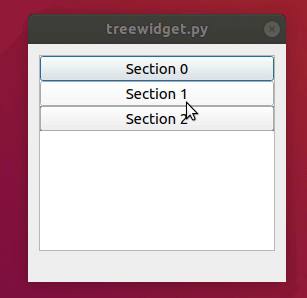一、功能说明:
- 想点击一个按钮,折叠/展开一个widget
二、预览

三、PyQt5代码如下:
1 | # -*- coding:utf-8 -*- |
求知若渴 虚心若愚

1 | # -*- coding:utf-8 -*- |
运用你所掌握的数据结构,设计和实现一个 LRU (最近最少使用) 缓存机制。它应该支持以下操作: 获取数据 get 和 写入数据 put 。
获取数据 get(key) - 如果密钥 (key) 存在于缓存中,则获取密钥的值(总是正数),否则返回 -1。
写入数据 put(key, value) - 如果密钥不存在,则写入其数据值。当缓存容量达到上限时,它应该在写入新数据之前删除最近最少使用的数据值,从而为新的数据值留出空间。
进阶:
你是否可以在 O(1) 时间复杂度内完成这两种操作?
示例:
LRUCache cache = new LRUCache( 2 / 缓存容量 / );
cache.put(1, 1);
cache.put(2, 2);
cache.get(1); // 返回 1
cache.put(3, 3); // 该操作会使得密钥 2 作废
cache.get(2); // 返回 -1 (未找到)
cache.put(4, 4); // 该操作会使得密钥 1 作废
cache.get(1); // 返回 -1 (未找到)
cache.get(3); // 返回 3
cache.get(4); // 返回 4
list(列表) + unordered_map(hash表)来实现1 | #include <iostream> |
OrderedDict
1 | # -*- coding:utf-8 -*- |
给定一个非空二叉树,返回其最大路径和。
本题中,路径被定义为一条从树中任意节点出发,达到任意节点的序列。该路径至少包含一个节点,且不一定经过根节点。
示例 1:
输入: [1,2,3]
1
/ \
2 3
输出: 6
示例 2:
输入: [-10,9,20,null,null,15,7]
-10
/ \
9 20
/ \
15 7
输出: 42
max(当前节点、当前节点+左节点、当前节点+右节点、当前节点+左右节点)1 | #include <iostream> |
1 | #include <iostream> |
一个机器人位于一个 m x n 网格的左上角 (起始点在下图中标记为“Start” )。
机器人每次只能向下或者向右移动一步。机器人试图达到网格的右下角(在下图中标记为“Finish”)。
问总共有多少条不同的路径?
例如,上图是一个7 x 3 的网格。有多少可能的路径?
说明:m 和 n 的值均不超过 100。
示例 1:
输入: m = 3, n = 2
输出: 3
解释:
从左上角开始,总共有 3 条路径可以到达右下角。
示例 2:
输入: m = 7, n = 3
输出: 28
dp[i][j] = dp[i - 1][j] + dp[i][j - 1];1 | #include <iostream> |
n+m-2n+m-2中求n-1次往右走,或者m-1次往下走的情况C(n+m-2, n-1)或者C(n+m-2, m-1)给定一个链表,旋转链表,将链表每个节点向右移动 k 个位置,其中 k 是非负数。
示例 1:
输入: 1->2->3->4->5->NULL, k = 2
输出: 4->5->1->2->3->NULL
解释:
向右旋转 1 步: 5->1->2->3->4->NULL
向右旋转 2 步: 4->5->1->2->3->NULL
示例 2:
输入: 0->1->2->NULL, k = 4
输出: 2->0->1->NULL
解释:
向右旋转 1 步: 2->0->1->NULL
向右旋转 2 步: 1->2->0->NULL
向右旋转 3 步: 0->1->2->NULL
向右旋转 4 步: 2->0->1->NULL
t=(cnt - k % cnt) % cnt1 | #include <iostream> |
给定两个以字符串形式表示的非负整数 num1 和 num2,返回 num1 和 num2 的乘积,它们的乘积也表示为字符串形式。
示例 1:
输入: num1 = “2”, num2 = “3”
输出: “6”
示例 2:
输入: num1 = “123”, num2 = “456”
输出: “56088”
说明:
num1 和 num2 的长度小于110。
num1 和 num2 只包含数字 0-9。
num1 和 num2 均不以零开头,除非是数字 0 本身。
不能使用任何标准库的大数类型(比如 BigInteger)或直接将输入转换为整数来处理。
1 | tmp = result[i + j] + n1[i] * n2[j]; |
1 | #include <iostream> |
合并 k 个排序链表,返回合并后的排序链表。请分析和描述算法的复杂度。
示例:
输入:
[
1->4->5,
1->3->4,
2->6
]
输出: 1->1->2->3->4->4->5->6
好久没写C++,现在准备捡回来
c++中当定义类对象是指针对象时候,就需要用到 “->” 指向类中的成员;
当定义一般对象时候时就需要用到 “.” 指向类中的成员……
例如:1
2
3
4
5
6
7
8struct MyStruct
{
int member;
};
MyStruct a, *p;
a.member = 1;
p->member = 1;
(*p).member =1
总结:
1 | #include <iostream> |
1 | #include <iostream> |
给定一个包含 n 个整数的数组 nums,判断 nums 中是否存在三个元素 a,b,c ,使得 a + b + c = 0 ?找出所有满足条件且不重复的三元组。
注意:答案中不可以包含重复的三元组。
例如, 给定数组 nums = [-1, 0, 1, 2, -1, -4],
满足要求的三元组集合为:
[
[-1, 0, 1
[-1, -1, 2]
]
1 | package main |
假设按照升序排序的数组在预先未知的某个点上进行了旋转。
( 例如,数组 [0,1,2,4,5,6,7] 可能变为 [4,5,6,7,0,1,2] )。
搜索一个给定的目标值,如果数组中存在这个目标值,则返回它的索引,否则返回 -1 。
你可以假设数组中不存在重复的元素。
你的算法时间复杂度必须是 O(log n) 级别。
示例 1:
输入: nums = [4,5,6,7,0,1,2], target = 0
输出: 4
示例 2:
输入: nums = [4,5,6,7,0,1,2], target = 3
输出: -1
因为是递增的一次旋转数组,所以我们也可以用二分+我们特殊的判断来做
r=m-1,否则l=m+1l=m+1,否则r=m-11 | #include <iostream> |
给定一个包括 n 个整数的数组 nums 和 一个目标值 target。找出 nums 中的三个整数,使得它们的和与 target 最接近。返回这三个数的和。假定每组输入只存在唯一答案。
例如,给定数组 nums = [-1,2,1,-4], 和 target = 1.
与 target 最接近的三个数的和为 2. (-1 + 2 + 1 = 2).
< target时,j++,并且比较当前相差最小值+记录> target时,k–,并且记录当前相差最小值+记录= target时,直接返回target
1 | #include <iostream> |